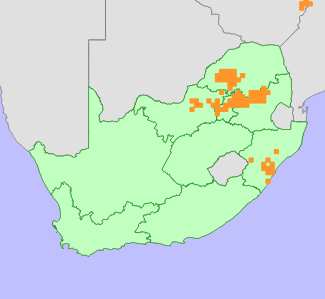|
Scientific Name | Protea welwitschii Engl. |
Higher Classification | Dicotyledons |
Family | PROTEACEAE |
Synonyms | Leucadendron welwitschii Hiern, Protea hirta Klotzsch (later homonym), not of L. (1771), Protea hirta Klotzsch ex Krauss, not of L. subsp. glabrescens Beard, Protea welwitschii Engl. subsp. glabrescens (Beard) Beard, Protea welwitschii Engl. subsp. goetzeana (Engl.) Beard, Protea welwitschii Engl. subsp. hirta Beard, Protea welwitschii Engl. var. glabrescens (Beard) Beard |
Common Names | Cluster-head Sugarbush (e), Dwarf Savanna Sugarbush (e), Isiqalaba (z), Kleinsuikerbos (a), Suikerbos (a), Troshofie-suikerbos (a), Welwitsch-se-suikerbos (a), White Sugar-bush (e), Witsuikerbos (a), Witsuikerboskan (a) |
National Status |
Status and Criteria | Least Concern |
Assessment Date | 2019/06/11 |
Assessor(s) | A.G. Rebelo, H. Mtshali & L. von Staden |
Justification | This is a widespread species in the eastern and northern provinces of South Africa. The existing threats to this species' habitats are unlikely to cause a severe population decline in the near future. It is therefore listed as Least Concern. |
Distribution |
Endemism | Not endemic to South Africa |
Provincial distribution | Gauteng, KwaZulu-Natal, Limpopo, Mpumalanga, North West |
Range | This species is widespread across northern South Africa, with an isolated subpopulation in southern KwaZulu-Natal. It is also widespread across southern and tropical Africa, occurring in Zimbabwe, Mozambique, Malawi and Uganda. |
Habitat and Ecology |
Major system | Terrestrial |
Major habitats | Mooi River Highland Grassland, Carletonville Dolomite Grassland, Rand Highveld Grassland, Eastern Highveld Grassland, Sekhukhune Montane Grassland, Lydenburg Thornveld, Strydpoort Summit Sourveld, Waterberg-Magaliesberg Summit Sourveld, Steenkampsberg Montane Grassland, Long Tom Pass Montane Grassland, KwaZulu-Natal Coastal Belt Grassland, Northern KwaZulu-Natal Moist Grassland, KwaZulu-Natal Sandstone Sourveld, Gauteng Shale Mountain Bushveld, Andesite Mountain Bushveld, Central Sandy Bushveld, Loskop Mountain Bushveld, Western Sandy Bushveld, Waterberg Mountain Bushveld, Dwarsberg-Swartruggens Mountain Bushveld, Marikana Thornveld, Moot Plains Bushveld, Gold Reef Mountain Bushveld, Dry Coast Hinterland Grassland |
Description | It is very variable in habitat, from subtropical to cool montane grasslands, 300-2000 m. It is a long-lived species, with a generation length of 50-100 years, and survives fires by resprouting from underground boles or rootstocks. Wind-dispersed seeds are released to lie on the ground and germinate under suitable conditions. It is pollinated by beetles and birds. |
Threats |
| While most of the population is not declining, there has been some loss of habitat, suspected to be less than 10%, to crop cultivation and urban and rural housing developments. This species is also susceptible to fire damage, and that probably accounts for the low-growing habit of many plants (Coates Palgrave, 2002). |
Population |
It is widespread with thousands of subpopulations known. Currently it is not declining.
|
Population trend | Stable |
Notes |
| It is extremely variable throughout its range. Although many varieties have been recognized in the past, some of which were geographically distinct, none is currently upheld by most taxonomists.
In Zimbabwe, this species can be confused with P. gaguedi. It is distinguished from this species by its unusual habit of producing 2-4 flower heads together, and the fact that its old flower heads open out flat when the seeds are shed, whereas those of P. gaguedi remain cup-shaped (Coates Palgrave 2002). |
Assessment History |
Taxon assessed |
Status and Criteria |
Citation/Red List version | | Protea welwitschii Engl. subsp. welwitschii | Least Concern | Raimondo et al. (2009) | | Protea welwitschii Engl. | Lower Risk - Near Threatened | Scott-Shaw (1999) | | Protea welwitschii Engl. subsp. welwitschii | Not Threatened | Hilton-Taylor (1996) | |
Bibliography |
Boon, R. 2010. Pooley's Trees of eastern South Africa. Flora and Fauna Publications Trust, Durban.
Coates Palgrave, M. 2002. Keith Coates Palgrave Trees of southern Africa. 3rd Edition. Struik, Cape Town.
Hilton-Taylor, C. 1996. Red data list of southern African plants. Strelitzia 4. South African National Botanical Institute, Pretoria.
Raimondo, D., von Staden, L., Foden, W., Victor, J.E., Helme, N.A., Turner, R.C., Kamundi, D.A. and Manyama, P.A. 2009. Red List of South African Plants. Strelitzia 25. South African National Biodiversity Institute, Pretoria.
Rebelo, T. 2001. Sasol Proteas: A field guide to the proteas of southern Africa. (2nd ed.). Fernwood Press, Vlaeberg, Cape Town.
Scott-Shaw, C.R. 1999. Rare and threatened plants of KwaZulu-Natal and neighbouring regions. KwaZulu-Natal Nature Conservation Service, Pietermaritzburg.
|
Citation |
| Rebelo, A.G., Mtshali, H. & von Staden, L. 2019. Protea welwitschii Engl. National Assessment: Red List of South African Plants version . Accessed on 2025/07/01 |
 Comment on this assessment
Comment on this assessment

